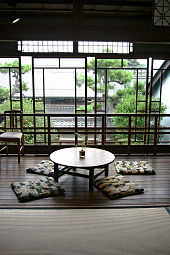拚觀光 日招待萬人免費遊東瀛
〔駐日特派員張茂森/東京二十五日報導〕為喚回因日本大地震流失的外國觀光客,決定免費 招待一萬名外國光客的計畫,日本觀光廳二十五日宣布三項主要條件,包括提出日本旅行計畫書、在自己的SNS(網路社交平台)或部落格發表感想,以及回答有 關日本印象的問卷調查。觀光廳也將架設專屬網頁公布詳細辦法,並在網頁上接受報名,目前網頁尚未架設完成。
日本「朝日新聞」二十五日報導,日本觀光廳當局將依申請人所提出的資料,以宣傳力的高低加以判斷,然後贈送免費機票,觀光廳長官溝火田宏表示,觀光廳希望被招待訪日的外國觀光客,能透過SNS或部落格傳達日本旅遊的安全性。
這項一萬人免費機票贈送案的概算要求中,機票與事務費大約十一億日圓,每人平均七至八萬圓,沒有上限,但在日食宿費必須自付,觀光廳認定一萬人到日本觀光的經濟效果約為十三億日圓,可以產生約為三十一億日圓的經濟效益。
日媒指出,今年九月訪日的外國觀光客比去年同期減少二十四.九%,雖比東北大震候的四月大減六十二.五%的數據增加很多,但增長速度仍然遲緩。日本政府期待外國觀光客訪日的目標,是希望能達到二○一○年的三.五倍,人數三千萬人。
***
林家三平と国分佐智子夫妻、そして三平の母・
Chabudai
A chabudai (卓袱台) is a short-legged table used in traditional Japanese homes. People seated at a chabudai may sit on zabuton and/or tatami rather than on chairs. The four legs of a chabudai are generally collapsible so that the table may be moved and stored easily.
Chabudai are used for various purposes, such as a study table for children, a work bench for needlework, and most importantly, a dinner table for the entire family (shokutaku (食卓、しょくたく)). In the winter, the chabudai is often replaced by a kotatsu, another type of short-legged table equipped with a removable top and a heater underneath.
[edit] Chabudai gaeshi
Chabudai gaeshi is a Japanese phrase meaning to flip [the] chabudai. Literally, it describes the act of violently upending a chabudai as an expression of anger, frustration, and disapproval. Video game designer Shigeru Miyamoto characterized chabudai gaeshi as an "action of old-fashioned Japanese fathers" which "would destroy the family" if attempted literally in modern Japanese society.[1] Chabudai gaeshi may also figuratively describe an analogous outburst and upheaval.
茶ぶ台


沒有留言:
張貼留言